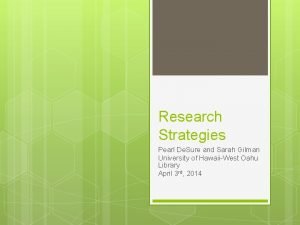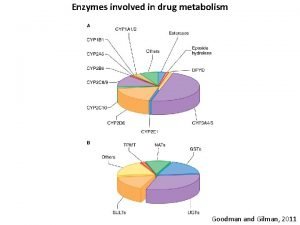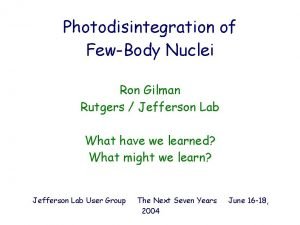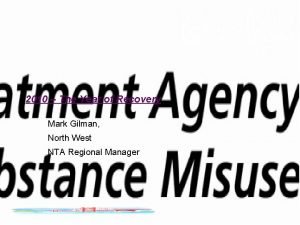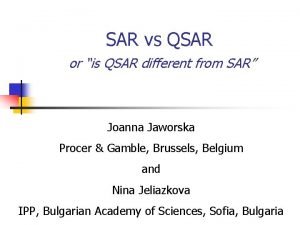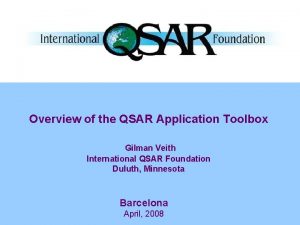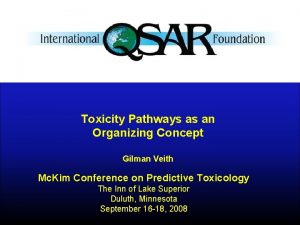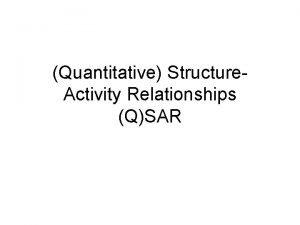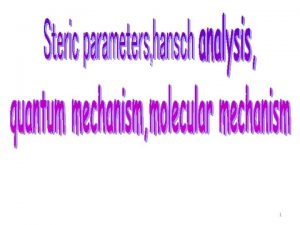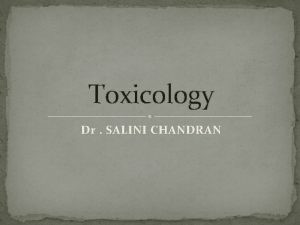QSAR in Predictive Toxicology Gilman Veith Mc Kim









- Slides: 9

QSAR in Predictive Toxicology Gilman Veith Mc. Kim Conference on Predictive Toxicology The Inn of Lake Superior Duluth, Minnesota September 25 -27, 2007

QSAR and Predictive Toxicology QSAR is intended to focus attention and resources on chemicals most likely to have a specific behavior. In predictive toxicology, QSAR provides the initial hypotheses before any testing is conducted Proper integration with other alternative methods will: -eliminate testing of chemicals with low hazards -eliminate testing of chemicals similar to tested surrogates -identify potential hazards of a chemical most relevant to safety -integrate toxicology into virtual systems models

Quantitative Structure-Activity Relationship • QSAR is an approach for understanding complex phenomena in chemical behavior • There are simple rules to this approach – – choose well-defined activity endpoints choose plausible molecular descriptors explore the data with statistics test hypotheses with new data (ie. iterate) These rules are ignored in 90% of QSAR papers)

Initial EU Interpretation • Select a defined endpoint • Select available descriptors for modeling • Gather training sets and create models • Emphasis on validation of statistical models instead of mechanisms

Flaws in Initial Efforts • Ignored the importance that QSAR models require two predictions: – predicting the intrinsic behavior (mechanism) – predicting the intensity factor (potency) • QSAR models focused on endpoint-training data regardless of mechanisms • QSAR models without clear logic for the domains are not accepted by regulators

What do we mean by Chemical Categories? • A group of chemicals that have some features that are common – Structurally similar e. g. common substructure – Property e. g. similar physicochemical, topological, geometrical, or surface properties – Behaviour e. g. (eco)toxicological response underpinned by a common Mechanism of Action – Functionality e. g. preservatives, flavourings, detergents, fragrances

Annex IX of REACH Substances whose physicochemical, toxicological and ecotoxicological properties are likely to be similar or follow a regular pattern as a result of structural similarity may be considered as a group, or “category” of substances. Application of the group concept requires that physicochemical properties, human health effects and environmental effects or environmental fate may be predicted from data for a reference substance within the group by interpolation to other substances in the group (read-across approach). This avoids the need to test every substance for every endpoint.

OECD Definition of Category • A chemical category is a group of chemicals whose physicochemical and toxicological properties are likely to be similar or follow a regular pattern as a result of structural similarity • These structural similarities may create a predictable pattern in any or all of the following parameters: physicochemical properties, environmental fate and environmental effects, and human health effects OECD Manual for Investigation of High Production Volume (HPV) Chemicals.

The Chemical Category Solution • Forming chemical categories shifted emphasis to intrinsic chemical activity • Entire categories of chemicals can be assessed when only a few are tested • Filling data gaps involves read-across & trend analysis, not just QSAR models • Enables defensible hazard assessment with elaborate QSAR models
